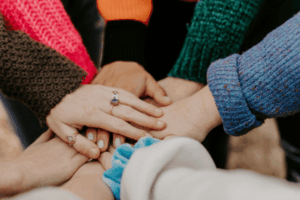
Providing a Level Playing Field for Women-Owned Businesses to Scale Up Globally
In the article, Unique Barriers Face Women-Owned Businesses, authors Maribel A. Dano-Luna (pictured left), Senior Researcher, and Rose Ann Camille (pictured right), Research Associate, Asian Institute of Management Rizalino S. Navarro Policy Center for Competitiveness, discuss the challenges women business owners face when exporting. We contacted Maribel and Rose Ann to find out what prompted them to write the article, why SMEs owned by men earn twice as much from share of exports versus women, and what can be done to further support women business owners to export more and be intimidated less. The edited excerpt of the interview follows.
Laurel Delaney: What prompted you to write the article?
Maribel A. Dano-Luna: The Asian Institute of Management R.S.N. Policy Center for Competitiveness conducts annual survey on small and medium enterprises (SMEs). For 2018, looking at women-owned SMEs has been pipelined in our research agenda and thus we wrote the working paper on Barriers to Scaling-up of [Women Small and Medium Enterprises] WSMEs. We are thankful for the Investing in Women Asia and ANU’s East Asian Forum Newsletter for picking up our study and giving us a platform to reach a wider audience through the commentary article.
LD: In your article you state, “while there are no significant differences in firm performance by gender, SMEs owned by men earned twice as much from share of exports to total sales compared with those owned by women.” Why is this and what can be done about it?
MDL: In the survey, we asked their reasons behind not exporting. Results show that in the Philippines, SMEs’ (both men and women-owned) top reasons for not exporting has to do with their entrepreneurial mindset – owner is content with the current state of business and they think it’s too risky. But specifically, women-owned SMEs compared with men-owned, are more likely not to export because of unsuccessful attempts in exporting in the past as well as lack of or difficult access to technology, raw materials or inputs. This signals the issue of confidence in terms of pursuing exporting which is generally perceived as risky.
We’ve had conversations last year with women entrepreneurs being assisted by the Philippine Commission on Women and they have raised the issue of difficulty in complying with exporting certification and standards, which contributes to the barrier for them to export and consequently, scale-up and grow.
LD: You also state, “The number one reason given for [women] not exporting was that the owner was content with the current state of business. Based on your findings, what can be done to further support women business owners to export more and be intimidated less?
Rose Ann Camille: In the Policy Center’s 2018 SME survey, results show that women entrepreneurs are more likely to place higher importance on mentoring or coaching programs for them to expand their business, including exporting. So, with a good mentoring program in place, it creates a positive impact on improving the entrepreneurial mindset of women entrepreneurs, making them more confident and less risk averse when it comes to engaging in exporting. Currently, we’re working with Department of Trade and Industry (DTI) Bureau of Small and Medium Enterprises to assess the impact of mentoring programs to SMEs. Also, we’ve highlighted the importance of belonging to a business network to elevate the social capital of women entrepreneurs.
LD: Increasing exports is a high priority for governments who wish to stimulate economic growth. How should governments intervene to assist, in particular, female business owners to export?
RAC: More targeted policies to foster an encouraging environment for women to start or join business organizations that will guide them in exporting.
MDL: Although in our overall survey study, we find that only 5.6% of SMEs are member of business organizations and thus efforts in raising awareness on the benefits of memberships in business organizations can be heightened. I think another aspect that needs further focus is in capacitation of women-owned SMEs to comply with exporting certification such as the Food and Drug Administration’s (FDA) accreditation. It’s a good thing that DTI has now launched a partnership with FDA to capacitate entrepreneurs on this. Our study also points to WSMEs access to technology. As we have pointed out in the EAF article, technology-intensive SMEs owned by women are significantly more likely to scale up. However, they tend to make limited use of more sophisticated technology — for example, e-commerce, websites, digital payment or cloud-based storage. Policies encouraging these entrepreneurs to make better use of their technology could boost their capacity to develop.
LD: Beyond your findings, what is the hidden, underlying message? What are we missing for women business owners that can elevate them to match the performance of their male counterparts?
MDL: I think more than contrasting men and women-owned SMEs and looking at the significant difference in their performance, we’ve found out that there are significant differences when it comes to reasons behind why some women-owned SMEs do not engage in exporting, innovation, expanding, nor applying for a loan.
Both the mindset and technical aspects are crucial to elevate SME performance. Policy incentives influencing extensive use of more sophisticated technologies, especially with the advent of Fourth Industrial Revolution are crucial for SMEs to not only scale-up in terms of firm size and sales but as well as in management and employee skills.
RAC: In our study, we can’t conclusively say that the challenges that they [women business owners] face is solely attributable to their gender. It’s definitely a confluence of other factors. What we wanted to highlight is that while women are more likely to start a business in the Philippines, they still lag behind men in terms of making their business thrive beyond the start-up phase. As mentioned in our study, women are less likely to borrow, engage in any innovation or expansion activities compared with men because of risk aversion, or their thinking that they are already content with the current state of their business. Again, the entrepreneurial mindset of the women plays a key role.
In closing, wegg® assists with all of the challenges Maribel A. Dano-Luna and Rose Ann Camille discuss on where women business owners need help with exporting: mentoring to export, accessing technology to export and building up confidence to export. To learn more about the entrepreneurial mindset of a woman business owner who currently exports, join us for our next free-of-charge wegginar® where CEO Cathy Koch, K-Tec Systems, talks about her quest for borderless growth.




